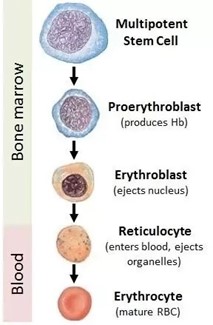Erythroblastosis fetalis may occur in:
A second Rh-negative fetus developing in an Rh-negative woman.
A second Rh-positive fetus developing in an Rh-negative woman.
A first Rh-positive fetus developing in an Rh-negative woman.
A first Rh-negative fetus developing in an Rh-negative woman.
The Correct Answer is B
This is because erythroblastosis fetalis, also known as hemolytic disease of the newborn, is caused by Rh incompatibility between the mother and the fetus.
Rh incompatibility occurs when a Rh-negative mother is impregnated by a Rh-positive father, resulting in a Rh-positive fetus.
The mother’s immune system can detect the Rh factor on the fetus’s red blood cells as foreign and produce antibodies against them.
These antibodies can cross the placenta and destroy the fetus’s red blood cells, causing anemia, jaundice, edema, and other complications.
Choice A is wrong because a second Rh-negative fetus developing in an Rh-negative woman will not cause erythroblastosis fetalis.
The mother and the fetus have the same Rh factor, so there is no immune reaction.
Choice C is wrong because a first Rh-positive fetus developing in an Rh-negative woman will not cause erythroblastosis fetalis.
The mother’s immune system will not produce antibodies against the Rh factor until after the first exposure to it, which usually happens during delivery.
Therefore, the first pregnancy is usually unaffected.
Choice D is wrong because a first Rh-negative fetus developing in an Rh-negative woman will not cause erythroblastosis fetalis.
The mother and the fetus have the same Rh factor, so there is no immune reaction.
The normal range of red blood cell count for newborns is 4.1 to 6.1 million cells per microliter of blood.
The normal range of bilirubin level for newborns is 0.3 to 1.9 milligrams per deciliter of blood.
Nursing Test Bank
Naxlex Comprehensive Predictor Exams
Related Questions
Correct Answer is A
Explanation
Red blood cells do not contain a large nucleus; in fact, they do not contain a nucleus at all when they are mature.
This is an adaptation that allows them to carry more hemoglobin, the protein that binds oxygen, and to squeeze through narrow capillaries.
Choice B is wrong because it contradicts the fact that red blood cells are enucleated (lacking a nucleus) in humans and most mammals.
Some vertebrates, such as birds and fish, have nucleated red blood cells, but they are not thick near the center and thin around the rim of the cell.

Correct Answer is C
Explanation
The popliteal artery is a continuation of the femoral artery that runs through the back of the leg and the knee.

It is located in the popliteal fossa, a hollow space behind the knee. The popliteal pulse can be felt behind the knee.
Choice A is wrong because the thymus is a gland in the chest, not in the leg.
Choice B is wrong because the liver, spleen, and upper gastrointestinal tract are organs in the abdomen, not in the leg.
Choice D is wrong because the colon and rectum are parts of the large intestine, not the leg.
Whether you are a student looking to ace your exams or a practicing nurse seeking to enhance your expertise , our nursing education contents will empower you with the confidence and competence to make a difference in the lives of patients and become a respected leader in the healthcare field.
Visit Naxlex, invest in your future and unlock endless possibilities with our unparalleled nursing education contents today
Report Wrong Answer on the Current Question
Do you disagree with the answer? If yes, what is your expected answer? Explain.
Kindly be descriptive with the issue you are facing.
